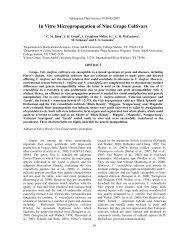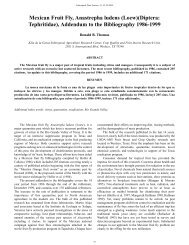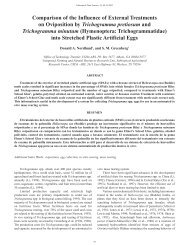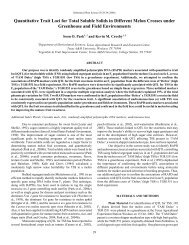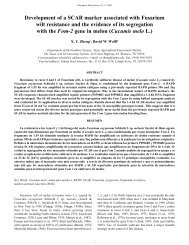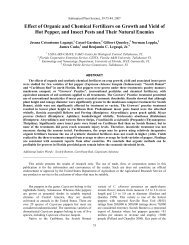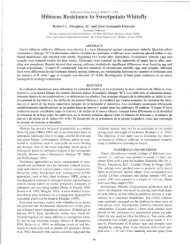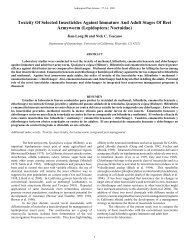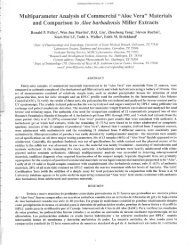Abstracts - Subtropical Plant Science Society
Abstracts - Subtropical Plant Science Society
Abstracts - Subtropical Plant Science Society
You also want an ePaper? Increase the reach of your titles
YUMPU automatically turns print PDFs into web optimized ePapers that Google loves.
Flash Chromatographic Separation and Isolation of Structurally Similar Flavanoid Glucosides<br />
Girija Raman and Bhimanagouda S. Patil<br />
Texas A & M University-Kingsville, Citrus Center, 306 N.International Blvd., Weslaco, TX 78596<br />
Flavanoid glucosides have been shown to prevent certain chronic diseases such as cancer, diseases of peripheral circulation<br />
and to lower blood pressure. Citrus molasses, a waste residue, has a large concentration of limonoid glucosides and flavanoid<br />
glucosides. Isolation of the pure glucosides from the mixture proves to be a complex problem due to their structural similarity. A<br />
rapid separation technique using a combination of adsorption chromatography and flash chromatography was designed to isolate<br />
these compounds from the mixture. The citrus molasses was de-pectinised and passed through ion-exchange resins to obtain an<br />
extract rich in glucosides. The enriched extract was agitated under cold conditions to separate the glucosides, which are present in<br />
maximum concentration. The freeze-dried extract was further separated using flash chromatographic technique. A small four-step<br />
gradient method using acetonitrile and water as mobile phase was developed. Structurally very similar flavanoid glucosides can be<br />
separated to the extent of 94%. This system can be used as a rapid technique for separation of closely related flavanoid glucosides.<br />
Development of a Trichoderma Based Biofungicide Suitable for<br />
Northern Tamaulipas Weather Conditions<br />
C. Patricia Larralde-Corona, Ma. Rufina Santiano-Mena, Cuauhtémoc Jacques, Diana Reséndez<br />
Center for Genomic Biotechnology, IPN, Reynosa, Tam., Mexico<br />
The northeast region of México comprises the states of Tamaulipas, Nuevo Leon and Coahuila, having common border with<br />
the south of Texas. Typical weather along this region varies from dry to hot sub-tropical, and specifically in the state of Tamaulipas<br />
we found mild alkaline and saline soils. Crops cultivated in this part of the country are mainly sorghum, cotton, maize, bean and<br />
okra. Disease-causing fungi commonly found are Aspergillus, Fusarium, Claviceps and Macrophomina. Some of these fungi can<br />
be predated by several species of the genera Trichoderma. Although several Trichoderma biocontrol products are reported, and<br />
some are even available in the market, the microorganisms used on them were isolated from regions of milder weather. We hence<br />
have focused on the isolation, characterization and formulation a biocontrol agent product suitable for the crops (mainly sorghum)<br />
of the north of Tamaulipas. We are using the fungus Macrophomina phaseolina as a disease causing agent model (Charcoal Stalk<br />
Rot), isolated from sorghum and maize at Río Bravo cropping zone, as well as isolates from other parts of México and Italy. During<br />
the first stage of this project, we isolated 9 Trichoderma strains, which had been characterized morphologically and by means of<br />
AFLP’s (amplified fragment length polymorphisms). We had also performed confrontation experiments for in vitro determination<br />
of the efficacy of biocontrol of the isolates at increasing temperatures, measuring the degree of growth inhibition as well as<br />
assessing the degree on invasion by means of an image analyzer. These results have allowed us to choose the most effective<br />
Trichoderma isolates to be used in the next stage in planta in the greenhouse.<br />
Agave durangensis Adaptation on Four Substrates<br />
Cuauhtemoc Jacques Hernández, Jesús García Olivares, J. Luis Hernández Mendoza,<br />
Angel Salazar Bravo, Felipe Serrano Medina, and Hugo Barrera Saldaña<br />
Center for Genomic Biotechnology, IPN, Reynosa, Tam., Mexico<br />
The micro-culture of plant tissues is an alternative technique for Agave plant production. The advantage of plants produced by<br />
this system is the feasibility to program the plant production, obtaining healthy plants, industrial scope and selected plants for<br />
physiological genetic or commercial properties. In our laboratory we are making Agave durangensis cultures in a synthetic<br />
medium. After this, plants are transferred to plastic trays (with 98 holes) using 4 different substrates. The plant survival rates<br />
observed were 67, 92, 77 and 70% corresponding to clay, peat moss, clay-peat mixed (50-50%) and natural soil respectively. With<br />
respect to plant size, only 40% of plants less than 1 cm in height survive, compared plants 1 cm or more in height, which have a<br />
survival rate of about 98%.<br />
84



